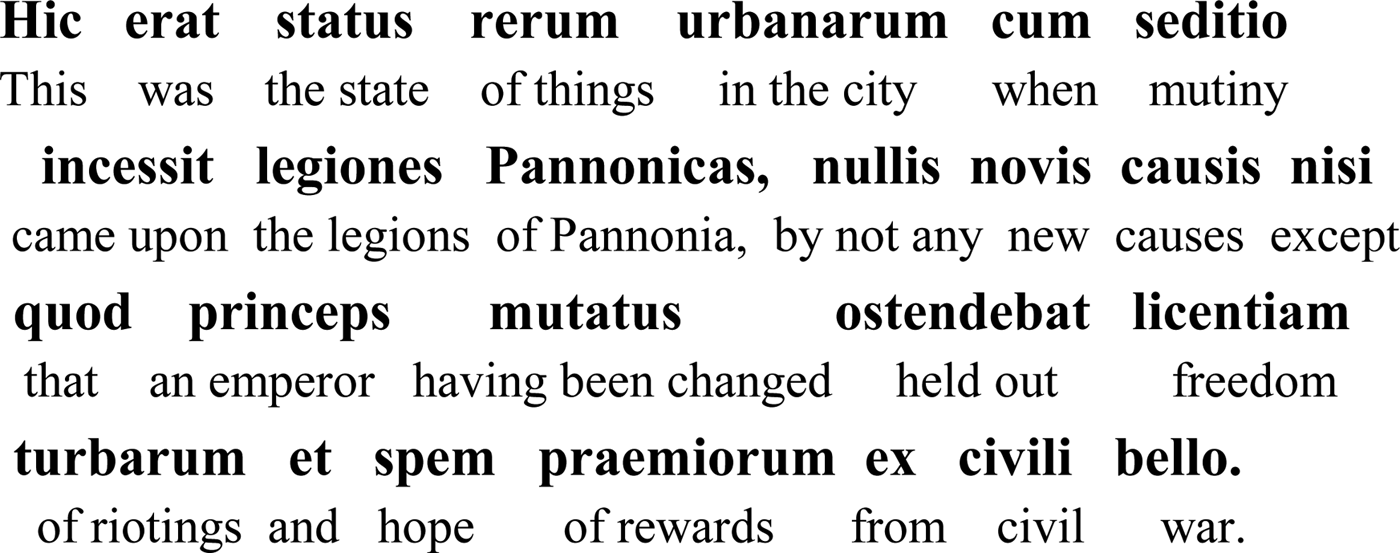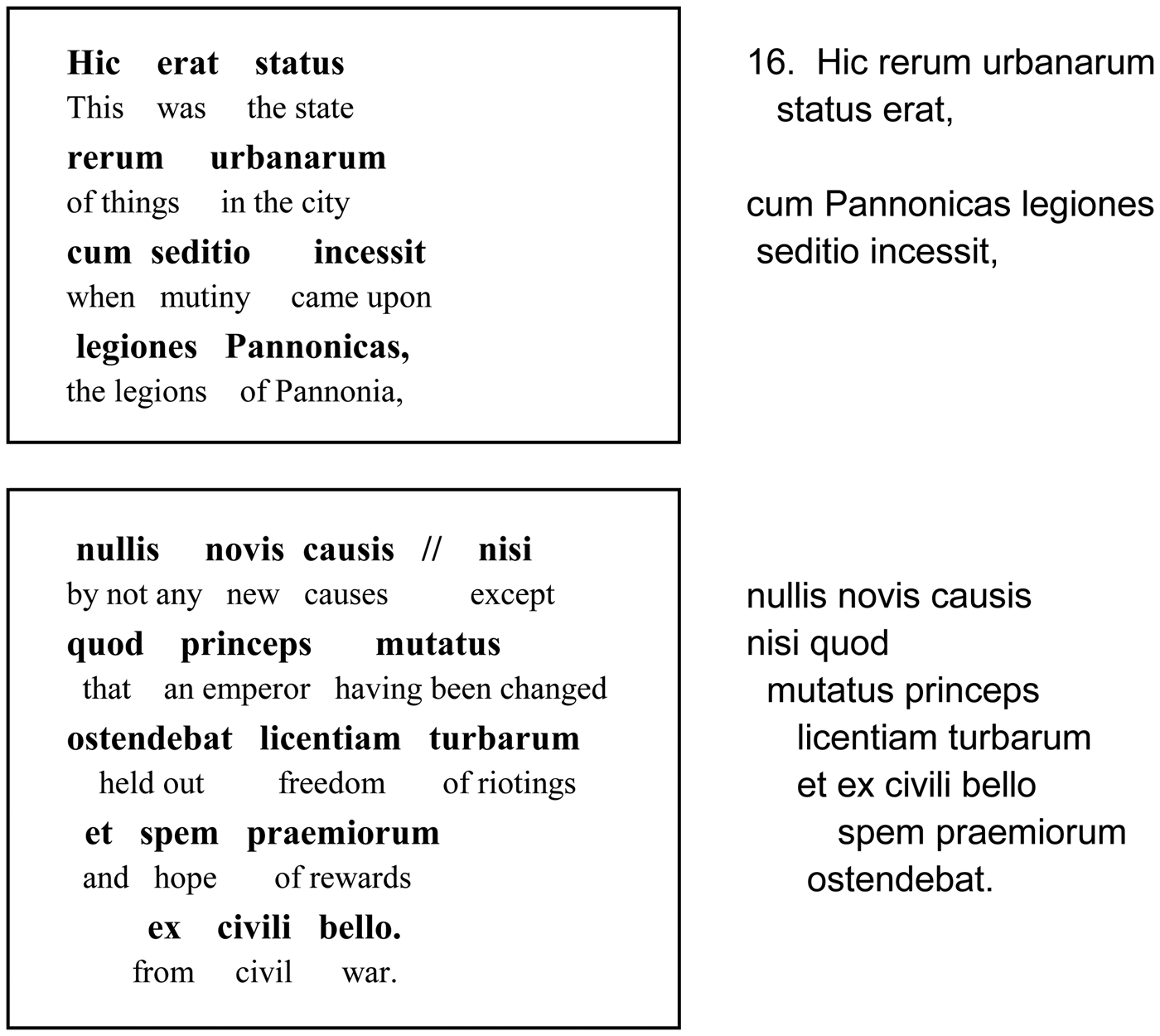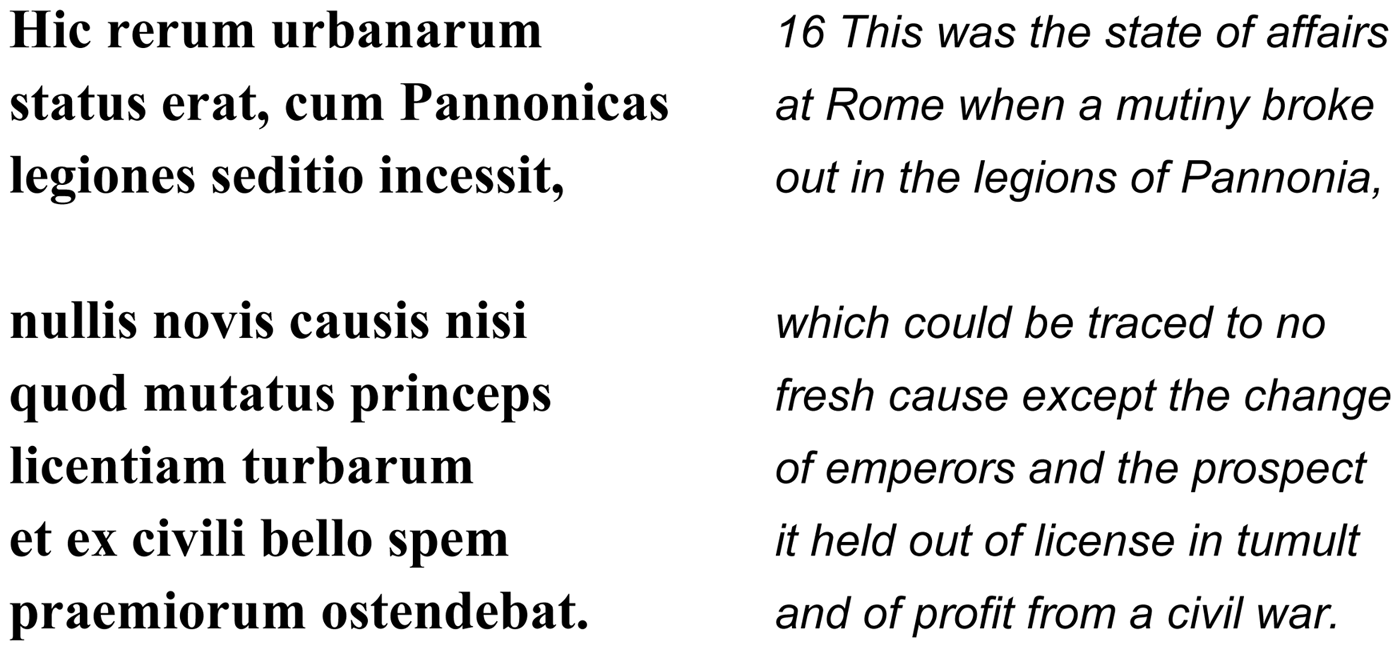Krashen's Comprehensible Input theory proposes that we acquire language when the brain understands messages. The practical question then arises: how do we make the foreign words in the message comprehensible to the brain?
Krashen recommends using language that is i + 1, where i is the student's current level in the L2.
But i + 1 is not the only route to comprehension.
When teaching literary Latin, a very effective way to make the language comprehensible is by translating it into the mother tongue, i.e. via L2 to L1 equivalence.
In this article I describe my own experience over the last eight years of making Latin literature comprehensible to students via translation. I then go on to discuss how translation may be used to develop ‘procedural’ knowledge and reading skills.
Research by Nation (Reference Nation2001) and others has found that, if a teacher wishes to make a foreign word comprehensible to a student, invariably the most effective way is to translate it, that is, tell the student what it means in their own language. Let us call this ‘Translation-based C’, that is, explaining the L2 by giving its equivalent in the L1.The potentialities of translation-based CI are rather remarkable and even after eight years I cannot yet say that I understand them all. This article describes current work in two areas.
The first part describes my own experience since 2010 of using translations to help students to read Latin literature.
The second part discusses how to use translation-based CI to remedy the central defect of traditional Latin teaching, that is, its complete failure to develop procedural knowledge in the student.
Background
I should explain that as well as teaching Latin and Greek I run a business www.classicalworkbooks.co.uk supplying workbooks to schools for students who are studying set texts for GCSE examination (16 year olds) and A level (18 year olds).
So, for this year's GCSE I have written workbooks for parts of Aeneid IV, Caesar on the Druids, Odyssey VI Nausicaa, Herodotus Solon and Croesus. For Latin A Level the texts were taken from Aeneid XI, Horace Satires, Cicero Philippics, Tacitus Histories.
In 2008 the on-line publication American Scholar contained an article entitled ‘An Old New Way of Learning Languages’ by Ernest Blum (Reference Blum2008). Blum gave an account of James Hamilton, who devised his ‘Hamiltonian System of Teaching Languages’ in the 1820's.
Hamilton used interlinear translations, which contain one line of Latin, below which is a line of English translation.
Further Googling uncovered an article by William Stevens (Reference Stevens1828) entitled the ‘Hamiltonian Experiment’ in which he described how he used Hamilton's method at Maidstone School to teach Latin beginners in two small classes over a 14-month period. In that 14 months one class read St John's Gospel, Lhomond's Epitome Historiae Sacrae, 25 Lives of Nepos, Caesar's Gallic War and Civil War, Sallust Jugurtha and Catiline, half of Livy Book 1, 2300 lines of Ovid and Aeneid Book I. After about 8 months these students reported that they were able to read a page of Caesar as quickly as they could read a page of English. The students involved were 10 years old.
Intrigued by this, I started using interlinear translations with my own students. They worked well, so I incorporated them into the workbooks in 2010. Using translations is officially frowned upon as ‘cheating’, but in practice students cannot read Latin literature without them so they are widely used.
Use of translations in teaching
In teaching beginner and intermediate students, some translations are useful, some are not. It depends on two main factors.
Firstly, the translation needs to be as literal as possible, rather than ‘good’.
Take, for example, Romanis ab Hannibale victis :
(literal) ‘with the Romans having been defeated by Hannibal’
(good) ‘after Hannibal had defeated the Romans’
The literal translation reproduces the Latin idiom and indicates to the student that that this is an ablative absolute construction. The good translation is better English but obscures the construction. Despised by the literati, the most helpful translations for students are the literal ‘cribs’ and ‘ponies’ of the 19th century like the Bohn series and Kelly's Key to the Classics.
The second factor is the ‘block size’. The smaller the block size, the more helpful the translation to the student. The Loeb Classical Library is known to everyone; it offers a ‘parallel’ translation, with a page of Latin facing a page of English. But with around 300 words to a page, the student seeking the meaning of an L2 word has to search through a block of 300 words of L1 to find it. And translations in Loebs tend to be good rather than literal, so there may be no direct L1 equivalent. In practice, Loebs are only really useful to advanced students.
Like a Loeb, Assimil's Latin Sans Peine by Desessard (Reference Desessard1966) has text and a facing parallel translation, but it splits up the text into individual sentences. So, when looking for the L1 equivalent of a Latin word the student now only has to look through one sentence - perhaps 5 to 15 words. The block size is 5-15.
Then there are ‘interlinear’ translations, which print one line of Latin and underneath it one line of English.
Hamilton took the interlinear concept farther by insisting that the student should be able to parse each individual Latin word in the line by referring to the English word below. So, in a Hamiltonian version there is a direct correlation between each Latin word and its English translation beneath, making a block size of 1. Hamilton made his translations extremely literal. And so that the translation should read easily as a whole, he re-arranged the Latin into the English word order. The end result is that a Hamiltonian interlinear gives the student the English meaning of each Latin word with pinpoint accuracy. Hamilton and his U.S. follower Thomas Clark (Reference Clark1857) produced interlinear translations of many Latin authors. These have all been digitised as part of the Google Books project and volumes in the Hamilton-Clark series are available from Abebooks or Amazon.
First Part Developments since 2010
Initially in 2010 I simply reproduced Hamilton's format. However, I have since modified it. The various formats are:
2010–2014: ‘Hamiltonian format’
The interlinear goes across the page, with a Latin line alternating with an English line, as below. The Latin is re-arranged into English word order.
Before a class, I would ask the students to use the interlinear translation to prepare the text in advance.
2015 – now: ‘Primer’ format
In 2014, while teaching Aeneid XII to a GCSE class of 15 year olds, I found that Virgil's Latin was simply too sophisticated for them to prepare before class, even when the meaning of each word was being supplied by the interlinear. Borrowing an idea from Claude Pavur, a languages professor at the University of St Louis, I broke up the text so that each line contained only one word-group (a cluster of words referring to a single idea). Then I combined both interlinear and original text onto a single page.
With this ‘primer’ layout I now no longer asked the students to prepare ahead of class. Instead I read the first line of the Latin aloud myself; the students then repeat the Latin aloud, then say the English meaning aloud. Speaking aloud allowed me to impart the meaning by tone of voice irrespective of the grammar. This worked very well and in my own teaching of literary texts I now always read the Latin aloud first to the students. The new layout was incorporated in all workbooks from 2015 onward. It is called a ‘primer’ because the interlinear text and translation in the box on the left ‘prime’ the student to read the original Latin text on the right.


2017 – now: ‘Parallel’ Layout
In 2017 I became interested in parallel translations, partly due to the Desessard Latin book (1966). But I had also discovered, purely by accident, that narrowing a column of Latin down to about 28 characters wide made it much easier to read. So, experimentally, in 2017 I did an A Level workbook of Tacitus Annals I with a parallel translation instead of interlinear.

However, teachers told me they preferred the interlinear translation because the English words correspond exactly with the Latin words. This helped their weaker students to see how the Latin fits together. So, I now use interlinear ‘primer’ translations in all workbooks.
Interlinear vs. parallel
Interlinears, with their one-to-one correspondence of L2 and L1, are appropriate when the Latin is far above the student's level of knowledge, as is the case with current A Level texts such as Tacitus Histories and Horace Satires. However, they are laborious to write and are re-arranged into English word order.
Parallels are easy to write and are in the original Latin word order. They are appropriate when the student is more experienced at Latin and the text not too far above their level of knowledge. This makes parallels ideal for ‘extensive reading’ and it now became a practical possibility to try to reproduce the results of Stevens (Reference Stevens1828).
Second Part Imparting procedural knowledge – the Dr. Stevens Project
At school it is common practice to teach students to dissect pieces of Latin by a process of grammatical analysis (‘where's the verb?’, ‘find the subject, find the object’, etc.). While being a necessary skill, the ability to dissect a Latin text is quite different from the ability to read it. Dissecting by analysis is slow and conscious and requires declarative knowledge (‘knowing that’). But reading is too fast (two or three words a second) to be performed by conscious analysis. The brain has to be trained to recognise the stream of words in a reflex action without conscious thought. This is procedural knowledge (‘knowing how’). Teaching reading is similar to teaching someone to play a musical instrument. The learner can practise scales etc., but at some point, he has to ‘let go’ and let the unconscious brain take over.
Extensive reading
The traditional grammar-translation method of teaching Latin makes no attempt to impart procedural knowledge; which is why none of our students ever learns to read Latin fluently. If we wish to teach our students how to read Latin, we have to look to Modern Language teaching for guidance. Here it is widely recognised that, to enable students to read, the brain has to be trained by constant practice and repetition in ‘Extensive Reading’ of large amounts of text. For further information, the ‘Guide to Extensive Reading’ from the Extensive Reading Foundation (ERF) (2019) will be found useful, as will Andrew Olimpi's article elsewhere in this issue.
Doctor Stevens
It will be recalled that Stevens (Reference Stevens1828) had his 10-year olds reading Caesar off the page after about 8 months. Stevens’ students read c. 193,000 words of Latin in 14 months. This contrasts with a modern-day sixth-former in the UK who in 20 months reads c. 8,000 words of set texts. So, the 10-year olds of 1828 were reading more than twenty-five times as much Latin as the 18-year olds of today.
It is surely reasonable to surmise that:
1) Stevens’ students were able to read Caesar off the page due to their extensive reading of large quantities of text, and that:
2) translation-based CI made their extensive reading possible in the first place.
The way ahead: spoon-feeding on a massive scale
The ERF (2019) stress that, to enable students to read extensively, the teacher should make their reading AS EASY AS POSSIBLE – in other words, spoon feeding.
Stevens made it easy by providing interlinear translations. It is a reasonable hypothesis, then, that a very effective way of teaching students to read Latin is: spoon-feeding on a massive scale by use of translations. To many teachers the idea of spoon-feeding will be unwelcome. So, it seems to me that the best way ahead is not to engage in theoretical arguments one way or the other, but simply to try to replicate Stevens results in practice – does massive spoon-feeding actually work? If it does, teachers can then make their own decisions on whether to stick with the intellectual rigour of grammatical analysis, or aim to develop reading skills through extensive reading with translations.
The Dr Stevens Project
Stevens (Reference Stevens1828) has left a detailed description of his experiment. The students spent about two and a half hours per day on Latin, half of which was spent on reading, half on grammar. In 2019 it is not realistic to do this with 10-year olds. In fact, such a trial is not practicable at all in UK secondary schools since the syllabus does not allow the time and teachers are locked into the examination system. Where it may work is with first-year university students who wish to study Classics but had no opportunity at school to learn Latin. They need to learn the new language as quickly as possible. The prospect of becoming fluent at reading Caesar after eight months will motivate them to devote the necessary time per day.
Initial trials with ‘H’
Recently I have started working with an 18-year old student, ‘H’. He is helping me to develop materials and clarify basic procedures so that we can turn Stevens’ experiment into a practicable course. After becoming interested in Classical Civilisation, H. realised he had to learn the languages. In his own time, he took Latin GCSE two years ago, and last year took A Level Greek along with his other A Levels. He is now taking a year out from school in order to take A Level Latin in June 2019, so he has time to spare. Since H. has taken Latin GCSE, we skipped the beginner materials and started with Cornelius Nepos. This is early days but so far certain facts have become clear.
Vocabulary
At the simplest level, the ability to read depends on how much vocabulary you know. The researches of Nation indicate that you need to recognise 95–98% of the words; anything below 90%-word recognition is ‘Frustration Level’. Therefore H. is aiming to read as much as possible as quickly as possible in order to build up vocabulary. At present he is reading one Life of Nepos every two days (there are 25 lives in all).
Nepos is fundamental
Nepos is the key author. His prose is plain and straightforward. Once the student has mastered Nepos, Caesar will follow on easily. (These two authors are the centrepiece of the project.)
Editions
We will use editions from the American ‘College series’ of the late 1800's, e.g. Kelsey's Gallic War (Reference Kelsey1897), Rolfe's Nepos (Reference Rolfe1894), Kelsey's Xenophon (Reference Kelsey1891). These are best because they cross-reference extensively to the major grammars (Allen and Greenough (Reference Allen and Greenough1903) for Latin, Goodwin (Reference Goodwin1892) for Greek). For Nepos we are currently using the Rolfe edition from Sophron. This dates from 1898 but the type has been attractively reset.
Grammar and Syntax.
A particularly interesting question is to what extent extensive reading will develop an instinctive ‘feel’ for correct inflexions and syntax in the student. But grammar rules still need to be explicitly taught; for us the preferred method is via English into Latin translation. For this we are using two textbooks of the grammar-translation era - Hillard and Botting's Elementary Latin Exercises (Reference Hillard and Botting1906), and North and Hillard's Latin Prose Composition (Reference North and Hillard1861). Answer keys are available for both, which make them suitable for the self-teach student.
Sequence of Reading
At the moment we think that the best sequence for working on a text is probably:
1. Start in the right-hand column of the parallel or parallel primer. Link each Latin word to its English meaning.
2. Move to the left-hand column. Read the Latin to yourself repeatedly until you are confident you know what it means.
3. Switch on ThePrinceSterling's version on Youtube (2019). Listen to him while reading the Latin. Having to keep up with the audio forces you to read quickly.
4. Later, as a separate exercise, go through the Latin text with an edition, grammar book and vocab list, and analyse any pieces of grammar and vocabulary you don't know.
5. Without reading the text this time, listen to ThePrinceSterling (2019) over headphones while doing some daily task like washing-up.
6. Build up a large vocabulary as quickly as possible by using some form of Spaced Repetition system.
At present H. is only doing 1, 2 and 3. At this very early stage we are simply aiming to read as much material as possible and see what happens. H. reports that while reading he already finds that his brain is predicting ahead more accurately what the Latin will be. He also finds that he is recognising words and understanding the Latin directly as he reads it. So that if you then ask him to translate the Latin into English, he has to go through a separate mental exercise to work this out.
Ready by mid-2019
We should have materials and a detailed set of procedures ready by mid-2019.If any readers of this article are responsible for language-teaching of first year undergraduates at university and would like to try Dr Stevens’ method, please get in touch.




